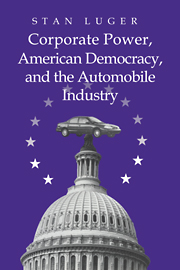Book contents
- Frontmatter
- Contents
- Acknowledgments
- Introduction
- 1 Studying Power in America
- 2 The Structure of the Auto Industry
- 3 Corporate Political Hegemony and Its Decline: 1916–1966
- 4 The Politics of Compromise: 1967–1978
- 5 The Resurgence of Corporate Power: 1979–1981
- 6 The Triumph of Corporate Power: Regulatory Policy, 1981–1988
- 7 The Triumph of Corporate Power: Trade Policy, 1981–1985
- 8 Interregnum: 1989–1996
- Conclusion: Corporate Power and American Democracy
- Index
Conclusion: Corporate Power and American Democracy
Published online by Cambridge University Press: 08 October 2009
- Frontmatter
- Contents
- Acknowledgments
- Introduction
- 1 Studying Power in America
- 2 The Structure of the Auto Industry
- 3 Corporate Political Hegemony and Its Decline: 1916–1966
- 4 The Politics of Compromise: 1967–1978
- 5 The Resurgence of Corporate Power: 1979–1981
- 6 The Triumph of Corporate Power: Regulatory Policy, 1981–1988
- 7 The Triumph of Corporate Power: Trade Policy, 1981–1985
- 8 Interregnum: 1989–1996
- Conclusion: Corporate Power and American Democracy
- Index
Summary
The problem of modern democracy is much less the fencing of political power than its rational utilization and provision for effective mass participation in its exercise.
Franz NeumannIt is difficult to fully grasp the impact of the automobile on American society. Appearing wholly natural, the entire man-made landscape has been reshaped for the use of motor vehicles. Cars are one of the characteristic commodities of our time, offering a blend of modern technology and individualism. They have been linked to the deepest elements of the psyche, merging power and violence, freedom and sexuality. Billions of dollars have been spent on advertising to define freedom as equivalent to individual mobility, to equate a new car with success, and to imbue particular models with different social identities. Indispensable in selling cars, these cultural values have also provided the automakers with a reservoir of latent public support. Understanding a broad range of social phenomena such as family life or dating patterns, traffic congestion or suburban development, air and noise pollution, or accidental deaths requires an analysis of an automobile-oriented culture and the power of its producers.
The endless highways of our metropolitan landscapes, often choked with traffic, evoke many of the contradictions of modern society. While individual cars offer convenience and mobility, they become increasingly less practical with each additional car they have to compete with. When cities are built or rebuilt for cars, the city – the sense of place so integral to civilized living – deteriorates. If the environment built for automobiles (drive-in restaurants, strip malls, and parking lagoons) is so aesthetically barren that it is aptly described as a “geography of nowhere,” it is a geography that nevertheless came from somewhere.
- Type
- Chapter
- Information
- Corporate Power, American Democracy, and the Automobile Industry , pp. 182 - 196Publisher: Cambridge University PressPrint publication year: 1999



